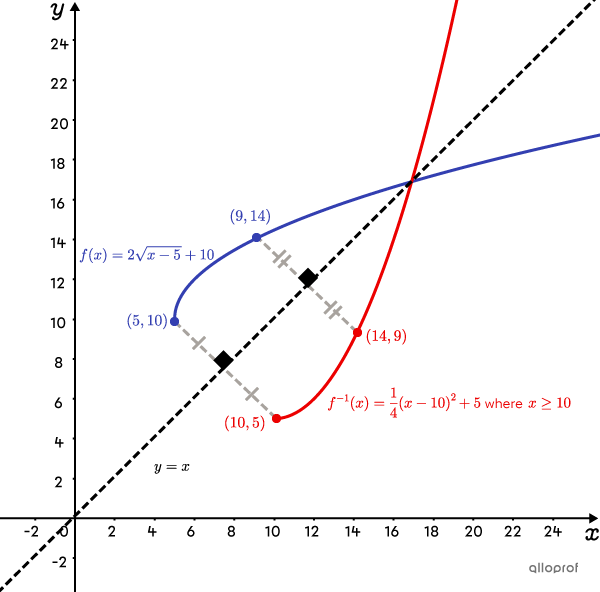Subjects
Grades
The inverse of a square root function is a quadratic function where the domain is restricted.
In the graph, |\color{#333fb1}{f^{-1}(x)}| is the inverse of the square root function |\color{#333fb1}{f(x)}.| Note that the domain of |\color{#333fb1}{f^{-1}(x)}| is equivalent to the range of |\color{#333fb1}{f(x)}.| It's the same for |\color{#ec0000}{g^{-1}(x)}| and |\color{#ec0000}{g(x)}.|
So, just calculate the initial function’s range to find the domain restriction of the inverse function.

Use the following steps to find the inverse rule when the function rule is given.
Switch |\color{#ec0000}{x}| and |\color{#333fb1}{y}| in the function rule.
Isolate |\color{#333fb1}{y}.|
Calculate the domain restriction of the inverse from the function’s range. For |f(x)=a\sqrt{b(x-h)}+k:|
|\text{dom}\ f^{-1}=\text{ran}\ f=\ ]-\infty,k]| if |a<0|
or
|\text{dom}\ f^{-1}=\text{ran}\ f=\ [k,+\infty[| if |a>0.|
Write the rule of the inverse.
Find the rule of the inverse of the function |f(x)=2\sqrt{x-5}+10.|
Switch |x| and |y| in the rule
||\begin{align}\color{#333fb1}{y}&=2\sqrt{\color{#ec0000}{x}-5}+10\\ \color{#ec0000}{x}&=2\sqrt{\color{#333fb1}{y}-5}+10\end{align}||
Isolate |y|
||\begin{align}x&=2\sqrt{y-5}+10\\ x-10&=2\sqrt{y-5}\\ \dfrac{x-10}{2}&=\sqrt{y-5}\\ \color{#ec0000}{\left(\color{black}{\dfrac{x-10}{2}}\right)^2}&=\color{#ec0000}{\left(\color{black}{\sqrt{y-5}}\ \right)^2}\\ \dfrac{(x-10)^2}{4}&=y-5\\ \dfrac{1}{4}(x-10)^2+5&=y\end{align}||
Calculate the restriction on the inverse’s domain
For |f(x),| |a=2| and |k=10.|
The parameter |a| of |f(x)| is positive, suggesting the function is defined above its vertex. So, the inverse function’s domain |f^{-1}(x),| which is equivalent to the range of |f(x),| is the following.
||\begin{align}\text{dom}\ f^{-1}=\text{ran}\ f&=[k,+\infty[\\&=[10,+\infty[\end{align}||
Give the rule
The function’s inverse |f(x)| is |f^{-1}(x)=\dfrac{1}{4}(x-10)^2+5| where |x\ge10.|
The curves of |\color{#333fb1}{f(x)}| and of |\color{#ec0000}{f^{-1}(x)}| from the previous example are found on the following Cartesian plane.
It is possible to plot the inverse of a function by interchanging the coordinates |x| and |y| of certain points. For example, the vertex |(\color{#333fb1}{5},\color{#333fb1}{10})| becomes the vertex |(\color{#ec0000}{10},\color{#ec0000}{5})| and the point |(\color{#333fb1}{9},\color{#333fb1}{14})| becomes |(\color{#ec0000}{14},\color{#ec0000}{9}).|

It can also be said that |\color{#ec0000}{f^{-1}(x)}| corresponds to the reflection of |\color{#333fb1}{f(x)}| regarding the line |y=x.| It is therefore possible to graph the inverse by reflection. For it to work, the scale of the |x|- and |y|-axes must have a ratio of |1:1.|